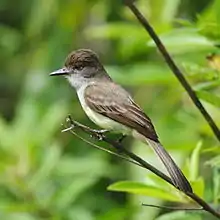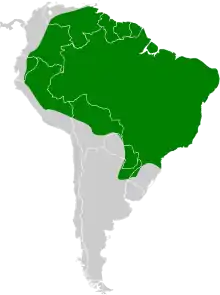Short-crested flycatcher
The short-crested flycatcher (Myiarchus ferox) is a species of bird in the tyrant flycatcher family Tyrannidae.
| Short-crested flycatcher | |
|---|---|
 | |
| at Bertioga, São Paulo State, Brazil | |
| Scientific classification | |
| Domain: | Eukaryota |
| Kingdom: | Animalia |
| Phylum: | Chordata |
| Clade: | Dinosauria |
| Class: | Aves |
| Order: | Passeriformes |
| Family: | Tyrannidae |
| Genus: | Myiarchus |
| Species: | M. ferox |
| Binomial name | |
| Myiarchus ferox (Gmelin, JF, 1789) | |
 | |
It is found in Argentina, Bolivia, Brazil, Colombia, Ecuador, French Guiana, Guyana, Paraguay, Peru, Suriname, Uruguay, and Venezuela. Its natural habitats are subtropical or tropical moist lowland forests and heavily degraded former forest.
Taxonomy
The short-crested flycatcher was formally described in 1789 by the German naturalist Johann Friedrich Gmelin in his revised and expanded edition of Carl Linnaeus's Systema Naturae. He placed it with the flycatchers in the genus Muscicapa and coined the binomial name Muscicapa ferox.[2] The specific epithet ferox is from Latin and means "brave", "wild" or "fierce".[3] Gmelin based his description primarily on "Le tyran de Cayenne" that had been described in 1760 by the French zoologist Mathurin Jacques Brisson. Brisson had examined both male and female specimens that had been sent to France from Cayenne.[4][5] The short-crested flycatcher is now one of 22 flycatchers placed in the genus Myiarchus that was introduced in 1844 by Jean Cabanis.[6] Within the genus Myiarchus, the short-crested flycatcher is genetically closely related to the Panama flycatcher (Myiarchus panamensis).[7]
Three subspecies are recognised:[6]
- M. f. brunnescens Zimmer, JT & Phelps, WH, 1946 – northeast Colombia and southwest Venezuela
- M. f. ferox (Gmelin, JF, 1789) – Amazonia
- M. f. australis Hellmayr, 1927 – east Bolivia to central, south Brazil, Paraguay, Uruguay and northeast Argentina
References
- BirdLife International (2018). "Myiarchus ferox". IUCN Red List of Threatened Species. 2018: e.T22700415A130206987. doi:10.2305/IUCN.UK.2018-2.RLTS.T22700415A130206987.en. Retrieved 12 November 2021.
- Gmelin, Johann Friedrich (1789). Systema naturae per regna tria naturae : secundum classes, ordines, genera, species, cum characteribus, differentiis, synonymis, locis (in Latin). Vol. 1, Part 2 (13th ed.). Lipsiae [Leipzig]: Georg. Emanuel. Beer. p. 934.
- Jobling, James A. (2010). The Helm Dictionary of Scientific Bird Names. London: Christopher Helm. p. 158. ISBN 978-1-4081-2501-4.
- Brisson, Mathurin Jacques (1760). Ornithologie, ou, Méthode Contenant la Division des Oiseaux en Ordres, Sections, Genres, Especes & leurs Variétés (in French and Latin). Vol. 2. Paris: Jean-Baptiste Bauche. p. 398, No. 21. The two stars (**) at the start of the section indicates that Brisson based his description on the examination of a specimen.
- Traylor, Melvin A. Jr, ed. (1979). Check-List of Birds of the World. Vol. 8. Cambridge, Massachusetts: Museum of Comparative Zoology. p. 200.
- Gill, Frank; Donsker, David; Rasmussen, Pamela, eds. (January 2023). "Tyrant flycatchers". IOC World Bird List Version 13.1. International Ornithologists' Union. Retrieved 21 March 2023.
- Harvey, M.G.; et al. (2020). "The evolution of a tropical biodiversity hotspot". Science. 370 (6522): 1343–1348. doi:10.1126/science.aaz6970. hdl:10138/329703. A high resolution version of the phylogenetic tree in Figure 1 is available from the first author's website here.
